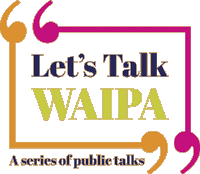
Day 2 - Saturday 19 July 2014
Cambridge Town Hall
10.00am Registration
10.15am Welcome - Councillor Sue Milner
10.30am Opening Address - Ngahuia Te Awekotuku
He Puna Roimata : making visual memories through public art
This session reflects on the ongoing expression of the Maori and settler history of the Waipa and Waikato confluence, through the media of public art works. They will include taonga Maori, monumental statements and smaller, more personal examples, in a visual presentation.
Chair Haupai Puke
Ngahuia Te Awekotuku is an award winning author who has worked as a museum curator, professor, art historian, and repatriation consultant. She has served on various governance boards in the arts, and the academy. She resides at Waiwherowhero, on the western bank of the Waikato River.
11.15am Catharine Coleborne
Health Institutions of the Waipa District in Historical Perspective
This session takes a look at several health institutions in the Waipa District from the nineteenth century into the twentieth. It examines their function in changing communities and highlights how families and groups used institutions to maintain health and to treat illness. Institutions provide us with an insight into lived communities of people; employment, cultures and interactions with the state, and show us how histories of health and illness might be interpreted in the present.
Chair Jan Pilditch
Catharine Coleborne is Professor in History at the University of Waikato. Her research has focused on histories of mental health in colonial Australia and New Zealand, but she has increasingly been developing teaching and research in local histories, such as her involvement in producing the collaborative book Changing Times, Changing Places, a history of mental health services in the Waikato, including Tokanui Hospital, which was published in 2012. She is also a Trustee of the Waikato Health Memorabilia Trust, and has a keen interest in the stories of health institutions and people and families who have interacted with them, both in the past and in the present. With Ondine Godtschalk, she published an article about colonial families and illness in Australia and New Zealand in the Journal of Family History (2013).
12.00pm Waikato Health Memorabilia Trust
Health and Medical Objects and the Waipa
This session will take a look at some of the physical objects associated with the Medical profession in the past.
Chair Catharine Coleborne
LUNCH: 12.45 – 1.45pm
1.45pm Philippa Ulenberg
High Art and High Jinks: serious music making and great fun at a summer school of music.
Q: What do Douglas Lilburn, Owen Jensen, John M Thomson, Jenny McLeod, Lili Kraus, Edwin Carr, Ronald Dellow, David Farquhar, Ronald Tremain, John Rimmer, Frederick Page, John Hopkins, Anthony Ritchie, Donald Munro, Jack Body, Maurice Clare, Judith Clark, Gary Brain, Vincent Aspey, Gillian Whitehead, Ian Campbell, David Griffiths, Katherine Austin, Robin Maconie, Peter Godfrey, Ian Whalley, Frances Wilson, Karen Grylls, Peter Walls, Ross Harris, Ray de Lisle, Michael Houston, Don McGlashan, John Wells, Deirdre Irons, Glenese Blake, Anthony Jennings, David Guerin, Margaret Nielson, Susan Frykberg, John Elmsly … all have in common?
A: The Cambridge Music School, 1946-1986. A post-World War Two adult-education initiative, the Cambridge Music School ran for two weeks each summer for 40 years at St Peter's School, making a major contribution to music performance and composition in New Zealand. It was a life-changing, direction setting experience for many of the students, who say they would never have been composers, singers or performers if it had not been for the Cambridge Music School.
Chair Kirstine Moffat
Phillippa Ulenberg graduated with a MA (music) in 2009 and a MMus (composition) in 2011. Her first book, In Sound Voice, Hamilton Civic Choir 1946 - 2006, was published in 2010. She is currently working towards a PhD which examines the Cambridge Summer School of Music.
2.30pm Kirstine Moffat
Gilbert and Sullivan in Waipa
In1891 the inaugural Te Awamutu Musical Society's performance of Trial by Jury 'enticed people from Kihikihi, Paterangi, Alexandra, and even Cambridge' (Waikato Times, 28 May 1891, p. 2). Since then, Gilbert and Sullivan's comic operas have been part of Waipa's entertainment scene, performed by schools, amateur societies, and professional companies. This talk explores this performance history and the reasons for the continuing appeal of Gilbert and Sullivan's topsy-turvy universe.
Chair Jan Pilditch
Kirstine Moffat is a Senior Lecturer in English at the University of Waikato where her research and publications focus primarily on nineteenth and early twentieth century New Zealand settlement writing. As well as books, music is one of Kirstine’s abiding passions. She started to learn the piano when she was five and is the author of Piano Forte: Stories and Soundscapes from Colonial New Zealand (Otago University Press, 2011).
3.15pm Stephen Harlow
Digital Histories: Moving stories online
If we want our young people to engage with stories of their past, put them where they will find them. YouTube has greater reach among 18-34 year-olds than any cable television channel. This presentation will describe a format that will help you tell the stories that are captured by the photographs and film in your archives to online audiences young and old. (In the time it has taken you to read this paragraph 100 hours of video has been uploaded to YouTube. Does it not make sense to move our stories online?)
Chair Jan Pilditch
Stephen Harlow: American poet Muriel Rukeyser is oft-quoted as saying that ‘The Universe is made of stories, not of atoms.’ As a one-time chemistry teacher this claim came as somewhat of a challenge. I can now see the truth in that line of poetry as I assist would-be digital storytellers to apply the hard digital computer skills to the softer, but no less difficult, art of storytelling. When I'm not helping people tell their stories digitally I develop e-learning at the University of Waikato.
AFTERNOON TEA
Programme

